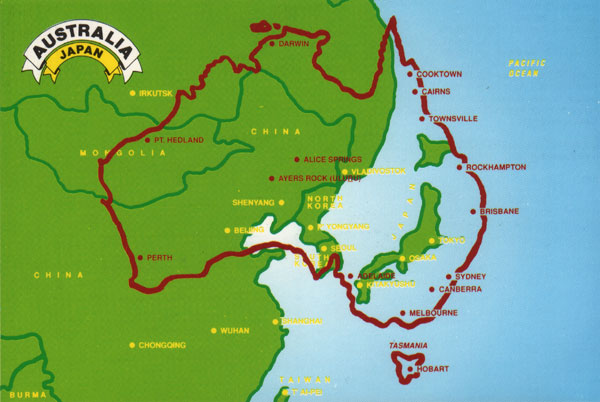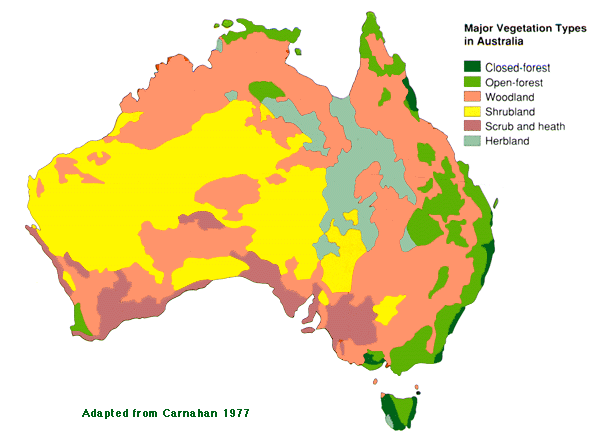Vegetation:
Nsw- open forest, woodland, closed forest and herb land
Qld- open forest, woodland, herb land and closed forest
Northern Territory- woodland, open forest and shrub land
Western Australia- shrubland, woodland and scrub and heath
South australia- shrub land, woodland and scrub and heath
Victoria- shrubland, open forest and scrub and heath
Act- open forest
Australian regional climates
- Tasmania has a cool temperature climate. The climate benefits are in summer when Tasmania escapes the searing heat and high humidity.
Victoria has a temperate climate as it is quite hot in summer but is cold and wet in winter.
Western New South Wales is mainly madeup of a grassland climate which means that it has lower rain but it is not as dry as a desert.
Eastern New South Wales is quite a temperate climate meaning that it has comfortable temperatures and regular amounts of rainfall.
South Queensland is mainly made up of grassland and subtropical climates. A subtropical climate is when it is warm and humid damp. It also has a bit of desert.
North Queensland is mainly grassland and tropical climates. A tropical climate is when summers are wet, dry and hot winters. There is also a bit of desert and equatorial climates in little parts of this region.
Northern Queensland is made up of mainly desert and grassland climates with a bit of desert and tropical climates.
North Western Australia is made up of a desert climate and a but of grassland and tropical climates
South Western Australia is made up of a desert climate with a bit of subtropical and grassland climates.
Key landforms and natural features:
Australia
Monday, 18 August 2014
Spatial dimensions
Australia has some of the best natural and man made features. Their vegetation covers 7 million square kilometers which is also 91% of Australia. Most of Australia's fauna and flora can not found anywhere else in the world. Australia is 20 times larger than japan. Australia is located in the south-eastern hemisphere. The latitude of Australia is 35.3080° S and the longitude of Australia is 149.1245° E. The width of Australia is 4000km and the length


Climate and vegetation in Australia
Because of the size of Australia, the climate varies widely. The greater part of the continent is desert or semi arid, leaving the corners and border of Australia being either temperate, grassland, subtropical, tropical, and very little being equatorial.
Australians native vegetation is one of the richest and most fundamental elements on our natural heritage. Our ancient soils, shelters, wildlife, streams, wetlands, coastlines, etc, are all sustained and nourished by our native vegetation.
Different regions receive the same amount of hours per day, but this does not mean that they receive the same amount of sunshine. Major vegetation types in Australia include woodland and shrub land. The rest of Australia vegetation is herb land, scrub and heath, and open forest. There is also very small amount of closed forest found along the east coast boarder of Queensland, NSW, Victoria, and also around both east and west parts of Tasmania.
Australians native vegetation is one of the richest and most fundamental elements on our natural heritage. Our ancient soils, shelters, wildlife, streams, wetlands, coastlines, etc, are all sustained and nourished by our native vegetation.
Different regions receive the same amount of hours per day, but this does not mean that they receive the same amount of sunshine. Major vegetation types in Australia include woodland and shrub land. The rest of Australia vegetation is herb land, scrub and heath, and open forest. There is also very small amount of closed forest found along the east coast boarder of Queensland, NSW, Victoria, and also around both east and west parts of Tasmania.
Thursday, 14 August 2014
Aboriginal
Dreaming the aboriginal heritage is a big part of Australian history. The dream stories always have important messages and life values. These stories pass on cultural values and The system of how they believe in what they do. Dreaming can be told through dance, song, paintings and storytelling. The dreaming has created a memories and a good cultural heritage. In Australia there is a real opportunity to experience the Aboriginal culture. Australia showcases many Aboriginal arts, dances, and heritage. By seeing this aboriginal heritage to can do many thing such as, The Rocks, Sydney, Royal Botanic Gardens Sydney, Taronga zoo, Tribal Warrior, Trippas White Group and Tri State Safaris.
Geological origins
Australia is flat because it's just a few feet above sea level and Australia's highest point is quite low too. There has been very little geological movement for millions of years. Mountains have now worn down to hills. It is flat because the late tectonics movements didn't collide Australia against another land mass to build mountains recently.
Australia is in the middle of a tectonic plate, rather than the edge, whole collision causes earthquakes. We don't lie anywhere near the fault zones. This is the same with volcanoes. Active volcanoes generally occur dole to the major tectonic plate boundaries, which there are none of in Australia.
That's why we are so flat and stable.
Indo-Australian plate : major tectonic plate that includes the continent of Australia and surrounding ocean, and extends northwest to include the Indian sub continent and adjacent waters. Studies suggest that the Indo-Australian plate may be in the process of breaking into two separate plates due primarily to stresses induced by the collision of the plate with Eurasia along the Himalayas.
Australia is in the middle of a tectonic plate, rather than the edge, whole collision causes earthquakes. We don't lie anywhere near the fault zones. This is the same with volcanoes. Active volcanoes generally occur dole to the major tectonic plate boundaries, which there are none of in Australia.
That's why we are so flat and stable.
Indo-Australian plate : major tectonic plate that includes the continent of Australia and surrounding ocean, and extends northwest to include the Indian sub continent and adjacent waters. Studies suggest that the Indo-Australian plate may be in the process of breaking into two separate plates due primarily to stresses induced by the collision of the plate with Eurasia along the Himalayas.
Subscribe to:
Comments (Atom)
